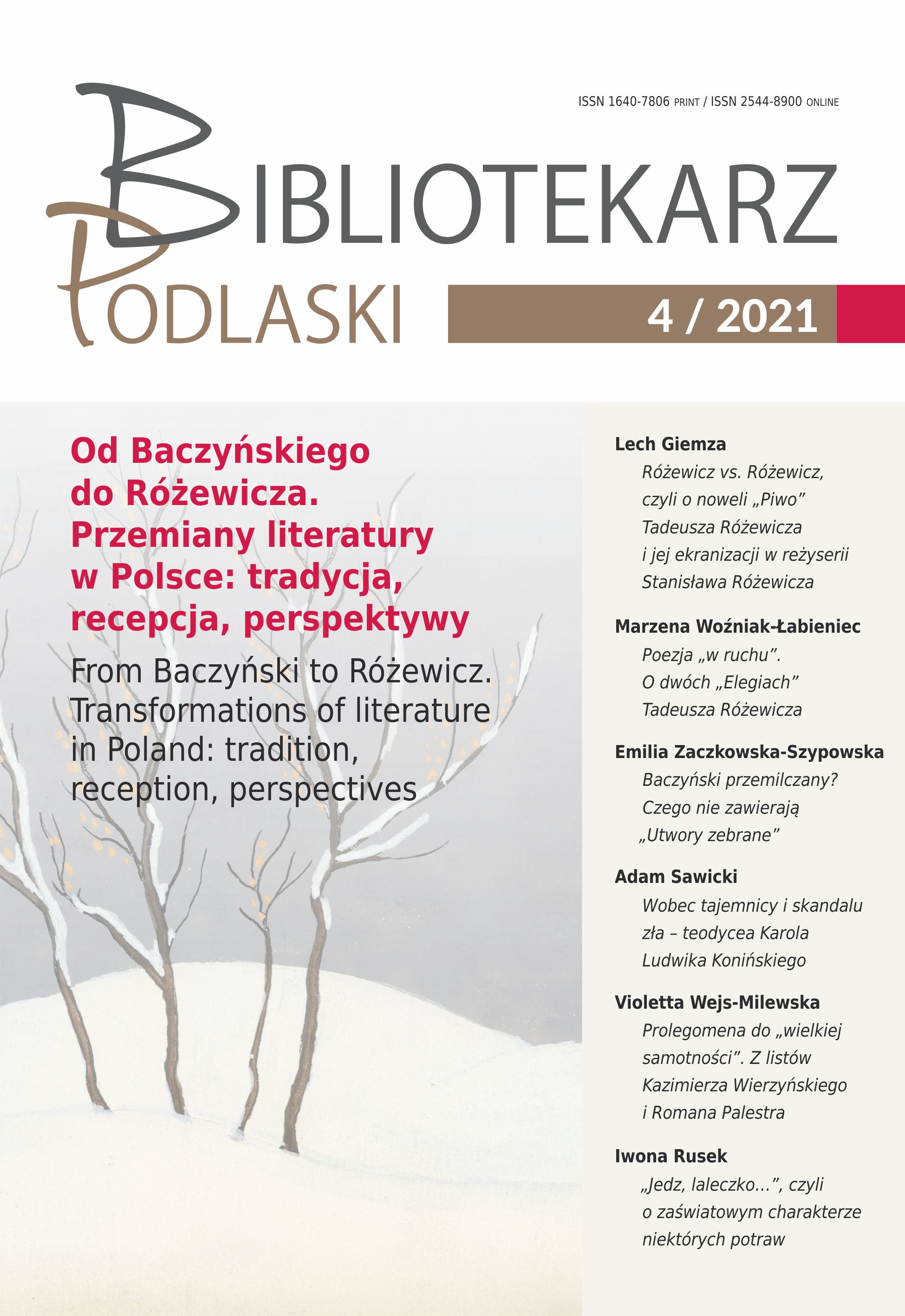Abstract
The aim of the article is to interpret a poem by Tadeusz Różewicz, Syn marnotrawny (z obrazu Hieronima Boscha) [The Prodigal Son (from the painting of Hieronymus Bosch)], from the volume Srebrny kłos [The Silver Ear of Corn] (1955). The poem is subjected to intertextual reading, which included strongly sketched autobiographical allusions, ecstatic descriptions of Bosch’s paintings and contextual references to the biblical parable of the prodigal son. Confronting the situation of the lyrical hero with the theological interpretation of the parable and reaching for the concept of reading the play proposed by Mieke Bal, ultimately reveals the kerygmatic meaning of the piece.
References
Bal M., Czytanie sztuki?, „Teksty Drugie” 2012, nr 1/2, s. 39–58.
Biała A., Syn marnotrawny. Malarskie inspiracje utworów Różewicza i Brandstaettera, „Polonistyka” 2006, nr 10, s. 18–24.
Białostocki J., Wybór pism estetycznych, Kraków 2008.
Biblia Jerozolimska, red. K. Sarzała, Poznań 2006.
Boczkowska A., Hieronim Bosch. Astrologiczna symbolika jego dzieł, Wrocław 1977.
Cieślak R., Oko poety. Imaginarium Tadeusza Różewicza. Próba rekonstrukcji, Gdańsk 1999.
Czekalski S., Nie ma nic poza galerią. Gramatologia, intertekstualność, związki międzyobrazowe, [w:] Twarzą w twarz z obrazem. Materiały Seminarium Metodologicznego Stowarzyszenia Historyków Sztuki, Nieborów 24–26 października 2002, red. M. Poprzęcka, Warszawa 2003, s. 19–57.
Dakowicz P., Poeta (bez)religijny. O twórczości Tadeusza Różewicza, Łódź 2015.
Dziadek A., Obrazy i wiersze. Z zagadnień interferencji sztuk w polskiej poezji współczesnej, Katowice 2004.
Ingarden R., O dziele literackim: badania z pogranicza ontologii, teorii języka i filozofii literatury, przeł. M. Turowicz, Warszawa 1960.
Janduła J., Obraz oczyma dzisiejszego historyka sztuki, [w:] Wizjer. Obraz w kulturze. Kultura obrazu. Poradnik dla nauczycieli, red. D. Abłamowicz, Bytom 2012, s. 32–42.
Panofsky E., Hercules AM Scheidewege Und andere antike Bildstoffe In der neueren Kunst, Leipzig–Berlin 1930.
Regiewicz A., Dlaczego starozakonni milczą? U źródeł antropologii obrazu, [w:] Poza horyzontem. Eseje o sztuce czytania (Ćwiczenia z poszukiwania sensu), Kraków 2015, s. 127–139.
Regiewicz A., Po co poetom Średniowiecze? Różewicz–Herbert–Miłosz, „Tematy i Konteksty” 2020, nr 10(15), s. 372–386.
Renger K., Versuch einer neuen Deutung von Hieronymus Bosch Rotterdam Tondo, „Oud Holand” 1969, R. 84.
Różewicz T., Syn marnotrawny (z obrazu Hieronima Boscha), [w:] tegoż, Wybór poezji, wstęp i oprac. A. Skrendo, Wrocław 2016.
Ruszar J. M., Syn marnotrawny (z Hieronima Boscha), [w:] Różewicz i obrazy, red. A. Stankowska, M. Śniedziewska, M. Telicki, Poznań 2015, s. 197–225.
Skrendo A., Wstęp, [w:] Tadeusz Różewicz. Wybór poezji, oprac. tenże, Wrocław 2016.
Wysłouch S., Literatura a sztuki wizualne. Problemy metodologiczne, [w:] Między tekstami. Intertekstualność jako problem poetyki historycznej. Studia, pod red. J. Ziomka, J. Sławińskiego, W. Boleckiego, Warszawa 1992, s. 218–226.
Wysłouch S., Literatura i semiotyka, Warszawa 2001.
Zaworska H., Sztuka podróżowania. Poetyckie mity podróży w twórczości Jarosława Iwaszkiewicza, Juliana Przybosia i Stanisława [i.e. Tadeusza] Różewicza, Kraków 1980.
Articles published in the “gold open access” mode on the basis of a non-exclusive license agreement between the publisher and the author. Permitted use:
- the publication may be read and stored on any device,
- the publication may be cited (with obligatory reference to the author, the title of the text, as well as the full title, bibliographic address of the issue and page of the journal)
The editorial team of “Bibliotekarz Podlaski” implements an open access policy by publishing materials in the form of the so-called Gold Open Access. From volume 42 (issue 1/2019), the journal is available under the Creative Commons license (Attribution – ShareAlike: CC BY-SA).
The key declarations of the Open Access and Open Science movement, which we fully support, are available on the CEON Open Science website.
COPYRIGHT:
The editorial team of “Bibliotekarz Podlaski” implements an open access policy by publishing materials in the form of the so-called Gold Open Access. The journal is available under the Creative Commons license – Attribution – ShareAlike 4.0: International: CC BY-SA 4.0).
The key declarations of the Open Access and Open Science movement, which we fully support, are available on the CEON Open Science website.
“Bibliotekarz Podlaski” allows its readers to read, download, copy, distribute, print, search and link to the full content of articles. We enable full, immediate, unlimited (both in a territorial, temporal and technical sense) open access to all published content, in accordance with the principle that freely available research increases and accelerates the global development of science and the exchange of knowledge.
The editorial team of “Bibliotekarz Podlaski” encourages authors to place articles published in the journal in open repositories (after the review or the final version of the publisher), provided that a link to the journal’s website is provided.
The journal does not charge the authors any fees for accepting and publishing their texts.


